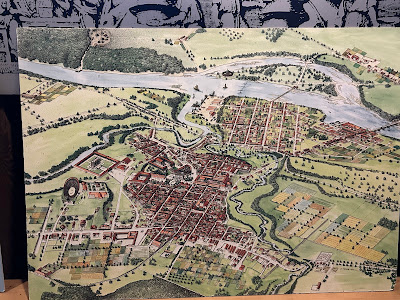Being as it is now in what can be known as "Central Europe", one sometimes forgets that - 2000 years ago - places like Switzerland were actually considered frontiers by the Romans. Such was the case of Augusta Raurica.
The site was originally founded as Colonia Augusta Rauricum) in 44 B.C. by a Roman (Lucius Munatius Plancus) near a Gallic tribe named the Rauraci - interestingly, although the name stuck, there is little evidence of the colony there, which was then essentially re-founded in 15 B.C. when Octavian Caesar Augusts conquered what is now Switzerland. The site was successful after that for many years, reaching a population of almost 20,000, serving as trading center exporting things like pork and bacon to the rest of the Roman Empire. It had baths, an amphitheater, a larger forum and smaller forums, and the largest Roman theater north of the Alps.
In A.D. 250 the site was seriously damaged by an earthquake, compounded by destruction by a Germanic tribe (The Alemanni) in A.D. 260. The location eventually separated into two towns, August and Kaiseraugust, which are now about 20 km/12 miles from Basel via light rail and bus. The site itself is essentially an open air museum that covers parts of the city not otherwise built over.
Augusta Raurica at its height as a Roman colony:
Types of grains the Romans would have grown and eaten:
The excavated and restored Roman theater:
Looking from the top of the theater towards the based of a temple:
As part of the restoration, a grain mill has been restored. Based on the items there, I suspect it is used for living history demonstrations as well.
Types of grains the Romans would have grown and eaten:











Hoo boy! Another glimpse of overseas and back in Time to boot! The Romans liked their theaters TB.
ReplyDeleteNylon12, it was a splendid site. I bet most folks do not go to it because it is a little off the beaten path.
DeleteLooks like a very interesting place to visit. Those Romans certainly did leave behind a lot of structures! The museum is really nice, and it would be especially interesting to see some demonstrations because the Romans had some ingenious ideas.
ReplyDeleteThe grains interested me. All were familiar except the dinkel. That's one I'm not familiar with so I looked it up. Apparently it's spelt!
Leigh, it was a very interesting place - almost an open air park of ruins. It looked like they had an annual festival; I have to admit following Roman re-enactment groups on InstaPic is endlessly fascinating.
DeleteOne of the sadder things is that there is so much that we keep finding that it means that there is so much that was buried now in places we cannot get to.
One of the things that gets buried in modern day histories is the fact that, under normal circumstances, the Roman army was largely vegetarian.